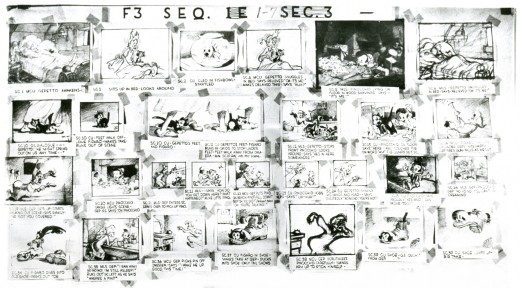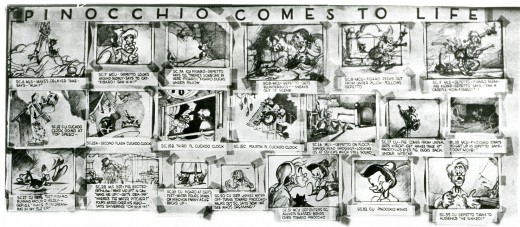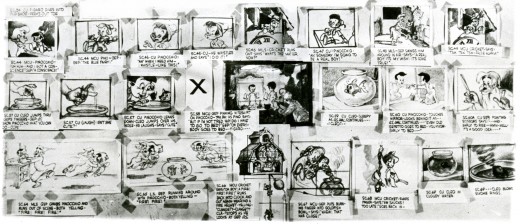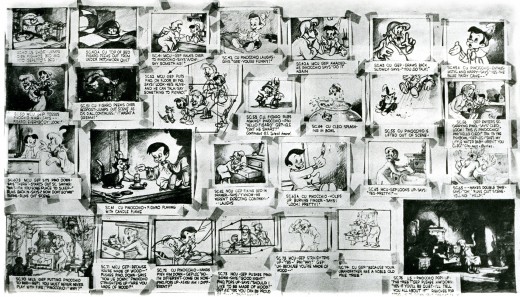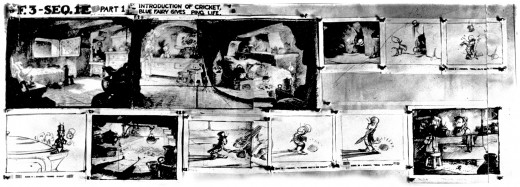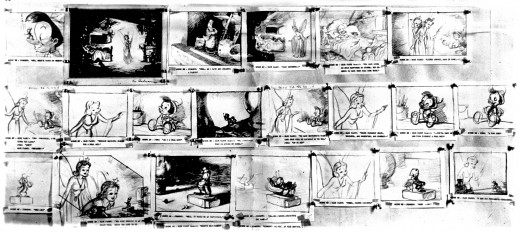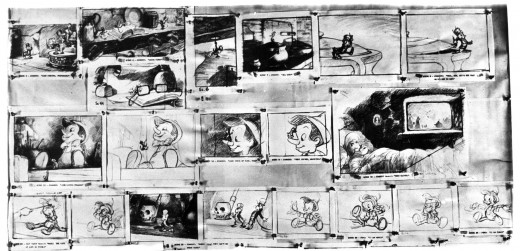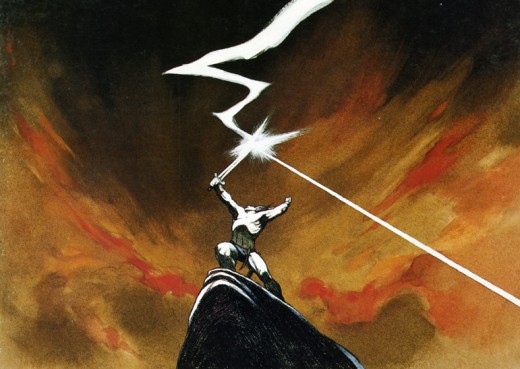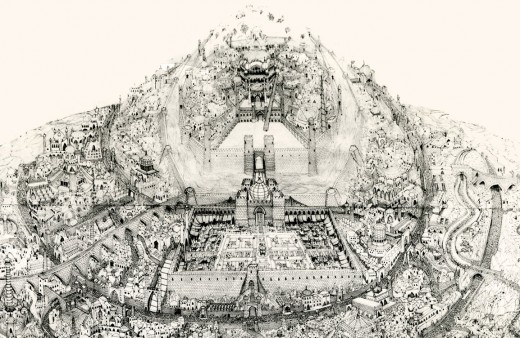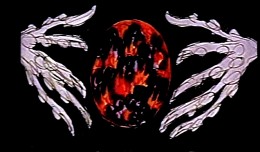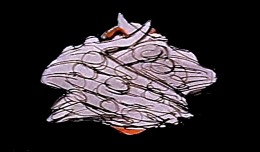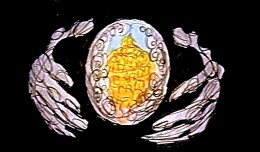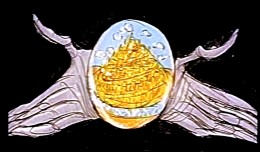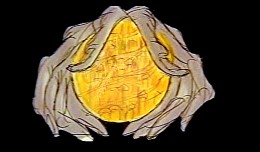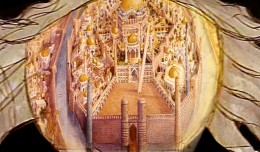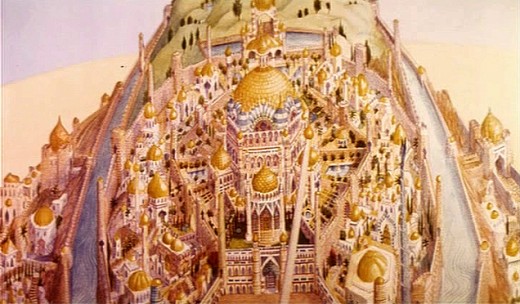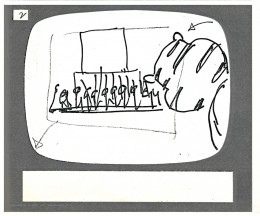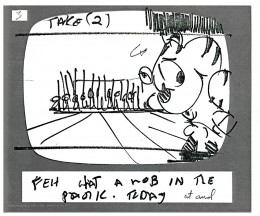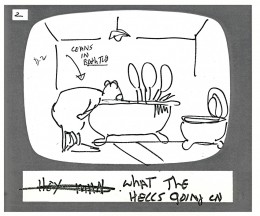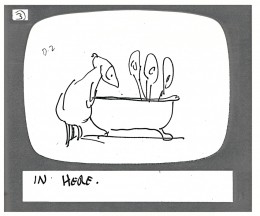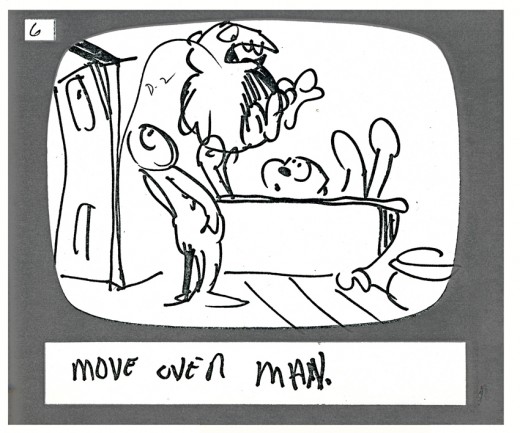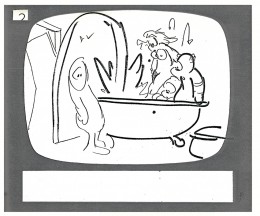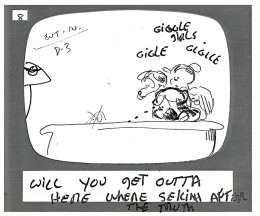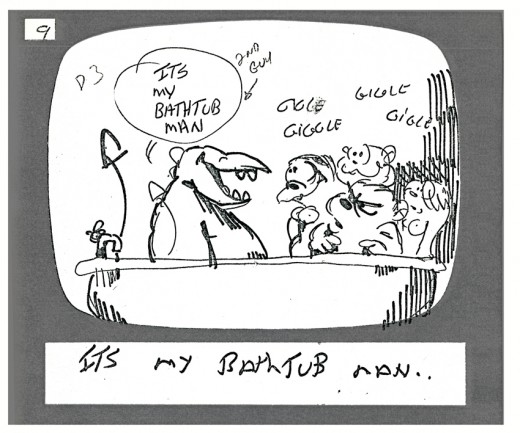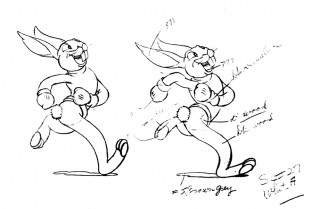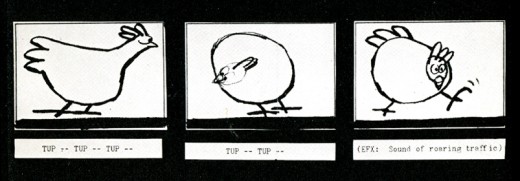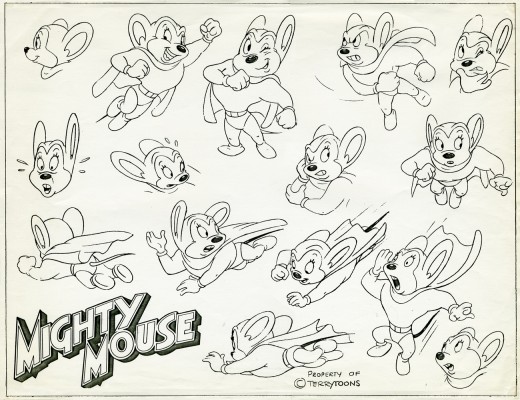Category ArchiveAnimation Artifacts
Animation Artifacts &Story & Storyboards 16 Mar 2007 08:09 am
Pinocchio Board #2
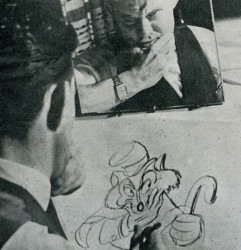 - Here’s the continuation of some of the Pinocchio storyboards which were loaned to me by John Canemaker. As Eddie Fitgerald and Floyd Norman pointed out in comments, these probably aren’t continuation boards; certainly they wouldn’t title one “Pinocchio Comes To Life.” My guess is that these were photographed for publicity, or else perhaps they’re early versions (except that the characters are obviously on model.)
- Here’s the continuation of some of the Pinocchio storyboards which were loaned to me by John Canemaker. As Eddie Fitgerald and Floyd Norman pointed out in comments, these probably aren’t continuation boards; certainly they wouldn’t title one “Pinocchio Comes To Life.” My guess is that these were photographed for publicity, or else perhaps they’re early versions (except that the characters are obviously on model.)
The two boards here seem to be two versions of the same sequence but different. The first one is compressed with lots of captions underneath the images; the second board is more spread out, more in the flow of the other boards.
(Click any image to enlarge.)
Regardless of why these boards were constructed, they contain images and thoughts that are good to see. Here they are; Gepetto discovers a real boy that was once a puppet:
Addendum: the images have been rearranged per comments of “the spectre” below. Now 1a goes to the left of 1b. 2a goes to the left of 2b.
Animation Artifacts &Story & Storyboards 14 Mar 2007 08:16 am
Pinocchio Board #1
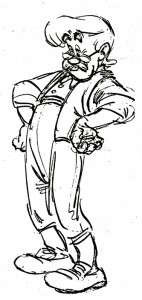 – John Canemaker came for a short visit and brought the real gold with him. He’s loaned me the photographic stats of the Pinocchio storyboard. The entire board isn’t there, but there’s sure a lot of it. We start with the Blue Fairy sequence. F3-1.3.
– John Canemaker came for a short visit and brought the real gold with him. He’s loaned me the photographic stats of the Pinocchio storyboard. The entire board isn’t there, but there’s sure a lot of it. We start with the Blue Fairy sequence. F3-1.3.
So I’ll post it a bit at a time. They’re large scans that have to be reconstructed in photoshop, and I’m doing that as time permits. I’m also trying to clean it up a bit since it’s a rather dark image. I’m trying to post it at the highest possible resolution so that it can be read, but that means I have to cut it in half again or it otherwise won’t load. (Since the board reads across row by row, I’m splitting it lengthwise to make reading easier.)
The type is still a bit small, but it’s the best I can do.
It’s a gem and something that should be out there now while Hans Perk posts the Drafts to the film and Mark Mayerson continues his Mosaic of the entire film. Hopefully, I’ll be able to catch up and keep up with him – a couple of posts a week.
Happy reading:
Animation Artifacts &Richard Williams 08 Mar 2007 08:18 am
Williams/Frazetta/Bakshi
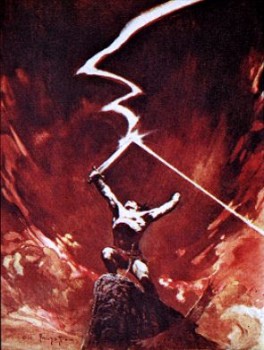 – Having given images of both Dick Williams’ work and Bakshi’s, I thought it’d be a good time to post the cel below. It reminds us of what an extremely talented animator and draftsman Richard Williams was – and still is.
– Having given images of both Dick Williams’ work and Bakshi’s, I thought it’d be a good time to post the cel below. It reminds us of what an extremely talented animator and draftsman Richard Williams was – and still is.
This is a cel from his commercial for Jovan done in Frank Frazetta‘s style.
(Frazetta’s original is pictured to the right.)
Of course, Williams captures the illustrator’s work better than Bakshi did in Fire and Ice (although to be fair Bakshi had an enormously lower per second budget.) There’s a gallery of some art from Bakshi‘s film here, and there’s a trailer for it on YouTube.
Dick Williams’ beautiful commercial ran briefly in 1978.
An image scanned from the cover of Funnyworld #19 runs beneath the cel to give an indication of what it looked like in the final. It appears to be a cel from the same scene – a bit closer on the character. The cel was given to me by Dick. (I also have another which matches the other Funnyworld illustration from this spot.)
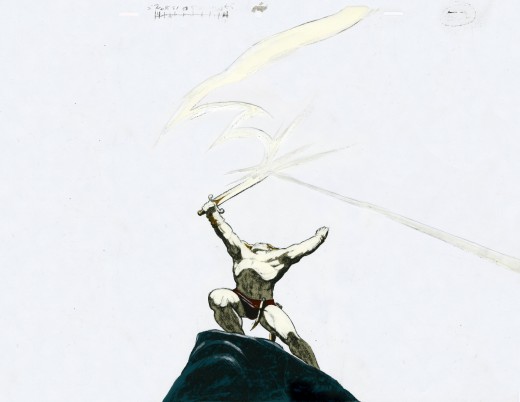
(Click on any image to enlarge.)
Dick animated the spot directly on cel with his Mars Omnichrome pencil (no longer available, of course.) There were six weeks for the entire production. Illustrator Rebecca Mills painted the backgrounds in oil. I remember Dick telling me how brilliant her work was while this commercial was in production.
Animation Artifacts &Richard Williams 06 Mar 2007 07:49 am
Dick’s World
- Let me share an image with you.
When Raggedy Ann & Andy was winding down, Richard Williams asked me, over dinner, whether I would be interested in working in London on his feature, The Cobbler and the Thief. He had in mind one sequence which he said would be all mine. This was the film’s opening – a slow truck into the island where all the action of the film would take place.
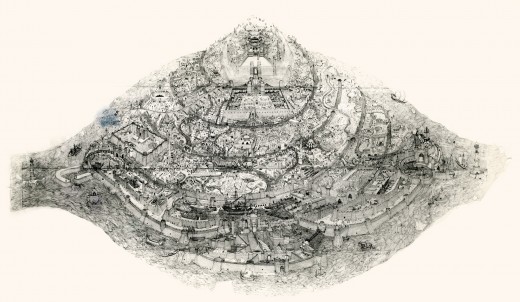 (Click on any image to enlarge.)
(Click on any image to enlarge.)
This was a photostat of this island. The original drawing, Dick had said, was enormous. It was composed of many smaller segments that were pinned together on a wall in his studio. If you look closely you can see those dividers in this photostat. To give a better indication of the detail in this drawing, I’m posting, below, a second image of a small portion of it.
The idea of it exhilarated me. I believe he said that Roy Naisbitt was involved with it, and that was something to get me going. I’d read about many of Dick’s staff and had already placed them on pedestals – including Roy’s work. I would not only get to meet them but work with them as well.
I decided not to take the job. I thought it would be better to remain friends with Dick than to continue working with him. That decision is something I don’t regret. It would have been fun to have been involved with that film, but so much has happened in my life by staying put, that I have no regrets.
The storyboard for the original cut of Dick’s film included these panels which led into the image of the animated city. A still of the city remained in the Miramax/Fred Calvert version, but that’s all.
Animation Artifacts 05 Mar 2007 08:10 am
Fritz, the cat
- Here are a few of the storyboard panels to Ralph Bakshi’s feature, Fritz the Cat. I find it interesting that they used those storyboard pads you can buy from art stores. It reminds me of my earliest days, long before I’d entered animation.
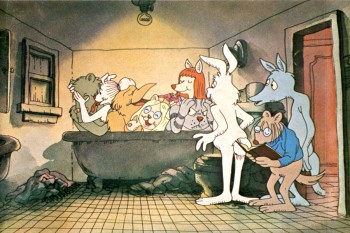 Somehow, I always assumed these pads were most appropriate for ads and advertising agencies and never thought that real studios used them. I couldn’t imagine paying the price for these pads of storyboard panels that were serrated to break apart individually. Why not just use pads of paper? I wonder if anyone who was at the Krantz/ Bakshi studio could explain it to me.
Somehow, I always assumed these pads were most appropriate for ads and advertising agencies and never thought that real studios used them. I couldn’t imagine paying the price for these pads of storyboard panels that were serrated to break apart individually. Why not just use pads of paper? I wonder if anyone who was at the Krantz/ Bakshi studio could explain it to me.
(Click any image to enlarge.)
I think the storyboard drawings here might be Cosmo Anzilotti‘s work; I’m not sure. The first four panels come from the opening of the film. The latter group come from the randy bathtub scene a couple of sequences later.
The color illustration above is from Mike Barrier‘s Funnyworld magazine, issue #14.
I encourage you to take the time to go to Mike’s site and read the Funnyworld Revisited section which includes the articles about Fritz in this issue. This was when Funnyworld was at its height, and the articles give a thorough account of the film and a real analysis. Why aren’t we getting the likes of this for any current feature? There are plenty of “The Art of . . .” books but too few critical evaluations. I can understand this for many of the studio features where writers are just bought into a project, but one wonders about the more independent films like The Triplettes of Belleville or Spirited Away. Only the blogs seem to have their spotty critical analyses.
The storyboard panels follow.
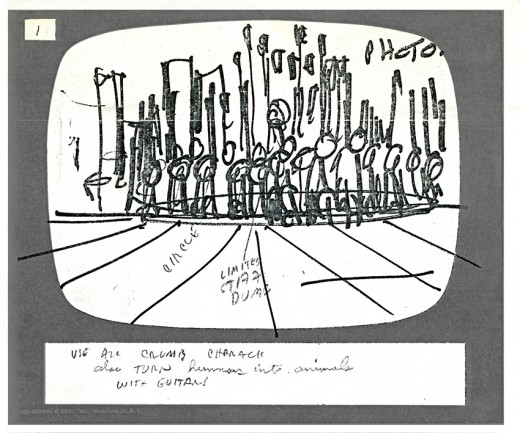
The background is identified as a “Photo.” Many of the backgrounds for the film were photos by Johnny Vita that he traced over in ink on a cel and painted with Luma dyes to match the lines.
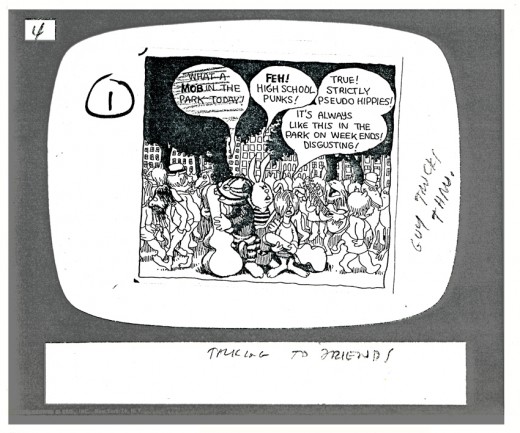
For this scene using one of Robert Crumb’s strip panels was enough.
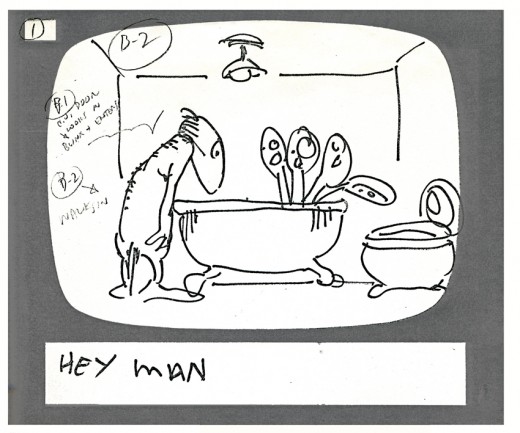
It’s interesting to see how the backgrounds are delineated on this storyboard drawing. From here on they ID the background on every storyboard drawing.
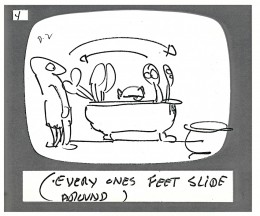
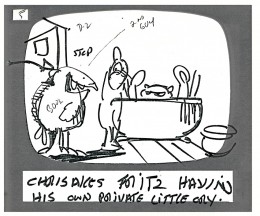
Note how the door has moved to the other side of the bathroom in the final (see color still above).
Animation &Animation Artifacts &walk cycle 01 Mar 2007 08:13 am
Max Hare
- Just to catch a breath of fresh air, I’ve decided to post this great run cycle of Max Hare from Disney’s 1935 Silly Symphony, The Tortoise and the Hare. I think it was Ham Luske who animated him; he did the bulk of the Hare in this film.
All drawings move from left to right. ![]()
(All drawings enlarge by clicking.)
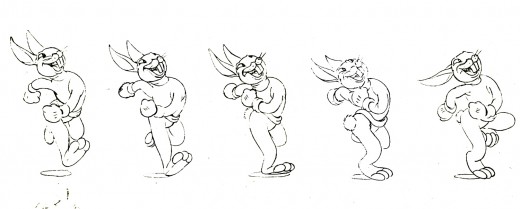
There’s a graceful beauty in this cycle. He saunters, more than runs. The tempo for it seems to be a basic 120, your average everyday walk cycle. I’d have to go back to the actual film to be sure.
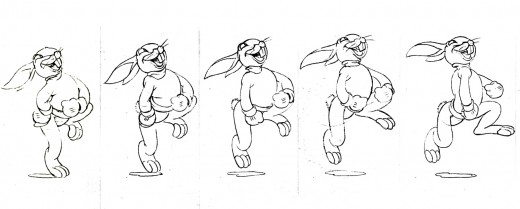
It’s interesting that he’s off the ground for 5 out of every 12 drawings. It helps create a delicate buoyancy overall. This is feasibly impossible, but it makes the run richer.
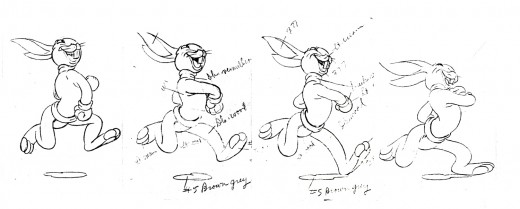
The arm movements tell you a lot about the character. He’s full of himself and moves his entire upper torso with the arm movements. He’s definitely showing off.
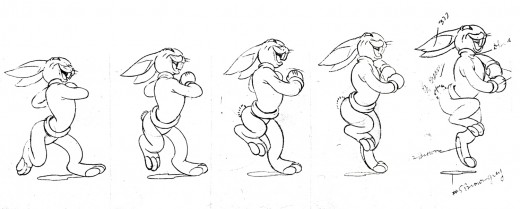
Mike Barrier has a good piece in his book, Hollywood Cartoons: American Animation in Its Golden Age, on Ham Luske’s animation of Max Hare. It’s reprinted on line here.
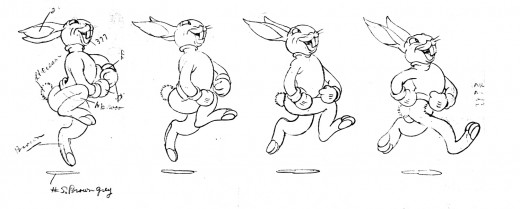
A number of the drawings have been marked up for color inking, and others have been marked for color painting.
Animation Artifacts &Hubley &Story & Storyboards 28 Feb 2007 08:04 am
Hub Boards
- The conversation on storyboard use goes way back – before the internet. If you check out the 1969 book by John Halas, Techniques of Film Animation, there’s a Q&A session wherein a number of animation greats were asked several questions, and the answers are given by question.
Here’s one question about storyboards and the answers given:
To what extent to you think a storyboard should be developed prior to production?
- GENE DEITCH: I believe in complete scene and shot breakdown in story-board or a thumbnail board form before production begins. I use a thumbnail storyboard as a sort of bar-sheet, indicating all effects, dialogue and music cues, scene transitions, etc. Great savings in cost, and an overall perspective of the film in advance are to be gained.
JOY BATCHELOR : As fully as possible without detriment to the following phases of production.
STEHPEN BOSUSTOW: If time and money allow, the storyboard should include as many details as possible, particularly if it is to be assigned to a large production unit. However, if only a few people are to be working on the picture, the storyboard can be quite sketchy, with the details being developed during production by the key people who have an overall feeling for and knowledge of the story.
ADRIAN WOOLERY: The storyboard is the first step, after the idea. Every problem must be solved and the story completely resolved on the board prior to consideration of any production.
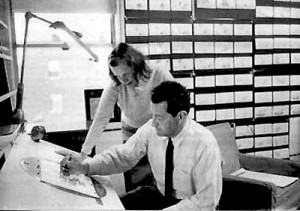 JOHN HUBLEY: It has been my experience that the more detailed a story-board and the more carefully it is designed to reflect the appearance of the finished production, the more successful the film.
JOHN HUBLEY: It has been my experience that the more detailed a story-board and the more carefully it is designed to reflect the appearance of the finished production, the more successful the film.GEOFFREY SUMNER: The storyboard, or breakdown of the film, has as many different forms as there are ways of putting actions in relation to one another.
The classic storyboard is the set of working drawings of the sequence of a film used in large studios on the Disney model where numbers of subsidiary workers must conform to a total pattern they can almost never see.
It is used in conjunction with model sheets. It could be called the “model sheet” of the sequence of the film.
It is strictly for use within a studio and should not be shown to dangerous people like sponsors.
An earlier stage is the treatment, which can be specifically directed at sponsors. If the basic idea of the film is simple, the treatment need be no more than half a dozen drawings and a brief synopsis to convey a ten minute film.
A storyboard must necessarily be constructed after the music has been done. The musician and the director can work together from a stage following the treatment. From the finished recorded track the storyboard is made.
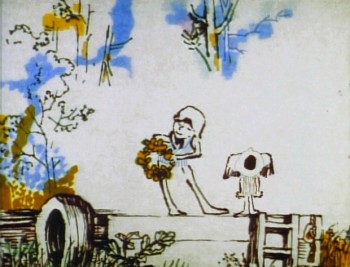 For years prior to even meeting Hubley, I had remembered his response to this question. It impressed me. His storyboard development was pretty intense. The scripts generally were done visually and tacked to the wall.
For years prior to even meeting Hubley, I had remembered his response to this question. It impressed me. His storyboard development was pretty intense. The scripts generally were done visually and tacked to the wall.
I don’t remember ever seeing text up there. John would present the board to key people, and he would give an indication of dialogue verbally. We all knew this would ultimately be ad-libbed by actors.
With the Carousel feature, sections were boarded but then developed in greater  length through improvised sessions. The boards then grew out of the edited tracks. The voices often came first, here.
length through improvised sessions. The boards then grew out of the edited tracks. The voices often came first, here.
I suspect this is probably also true of the films like Cockaboody, Windy Day and Moonbird which were dependent on the children’s verbal play at the microphone. Something like The Hole or Voyage To Next were boarded visually, then recorded improv sessions which were adapted in newer boards.
Of course it has to be remembered that the two features done within this studio, Everybody Rides The Carousel and Of Stars and Men, both started out as text. Both were heavy-duty books that were adapted for film. In the case of Of Stars and Men, the author, mathematician Harlow Shapely had major involvement in the film’s script and narrated it as well. The concepts for both films were fully worked out before anyone started boarding. So essentially a script – of sorts – existed. Since CBS financed Everybody Rides The Carousel, you know they had to approve a script.
I, of course, only remember the board.
Animation Artifacts 22 Feb 2007 08:01 am
Jabberwocky 1
- To me, Lewis Carroll‘s nonsense poem, Jabberwocky, is one of the most brilliant pieces ever written. It’s always been important to me, and I’ve collected many versions of it in illustrated versions. Now that I mention it, let me confess that I’m a Lewis Carroll addict, and Jabberwocky is one of my favorites among his many poems.
In film, you have the one live action feature by Terry Gilliam; it’s a good film with a clunky monster in the end. In animation, professionally, I know of only two versions completed. One was by Jan Svankmajer done in 1974. I did a version of it in 1989. Mine, of course, sticks closer to the poem even though it is pretty “arty”.
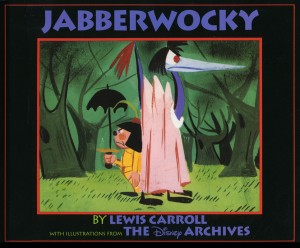 Apparently, there was also a version Disney was preparing as part of Alice In Wonderland. A book was published, credited to the “Disney Archives,” with illustrations from the preparatory drawings of this sequence. It’s obvious that the final versions of these drawings were done by one person, but there’s no record in the book of who did the finals.
Apparently, there was also a version Disney was preparing as part of Alice In Wonderland. A book was published, credited to the “Disney Archives,” with illustrations from the preparatory drawings of this sequence. It’s obvious that the final versions of these drawings were done by one person, but there’s no record in the book of who did the finals.
I’m not in love with the images in the book. I like the technique used, but I find the images too cute. Though, it’s amazing how current they look.
(Click on any image to enlarge.)
I’m going to give you a number of the book’s pages today and, in comparison, will follow it up with images from my version tomorrow.
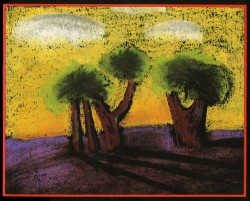
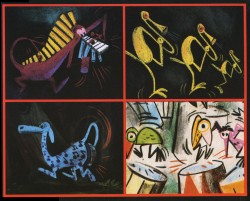
‘Twas brillig and the slithy toves
Did gyre and gimble in the wabe;
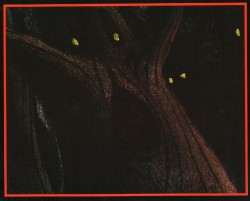
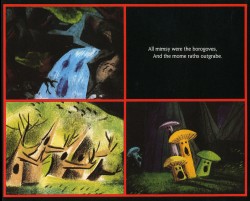
All mimsy were the borogoves,
And the mome raths outgrabe.
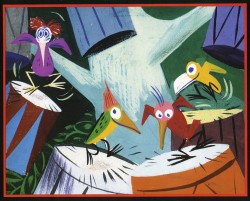
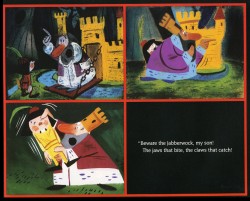
“Beware the Jabberwock, my son!
The jaws that bite, the claws that catch!”
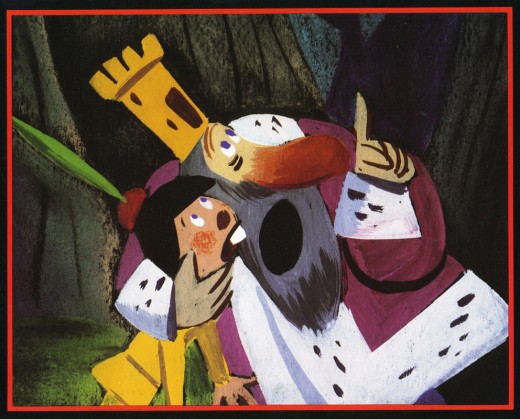
“Beware the Jubjub bird, and shun
The frumious Bandersnatch!”
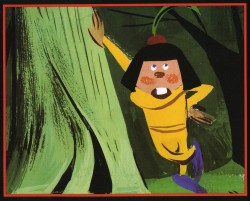
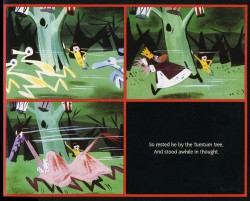
He took his vorpal sword in hand;
Long time the manxome foe he sought -
So rested he by the Tumtum tree
And stood awhile in thought.
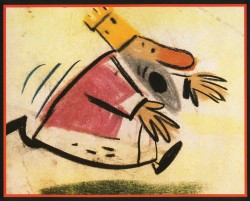
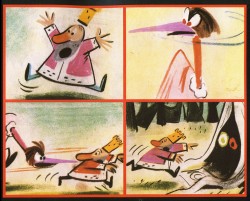
And as in uffish thought he stood,
The Jabberwock, with eyes of flame,
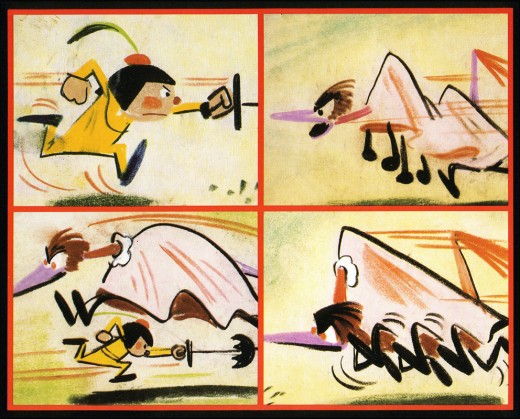
Came whiffling through the tulgey wood,
And burbled as it came!
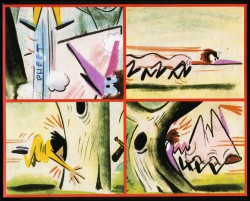
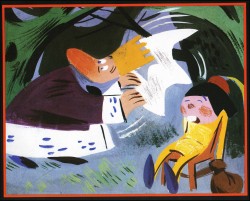
One, two! One, two! And through and through
The vorpal blade went snicker-snack!
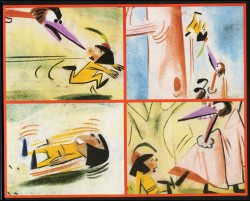
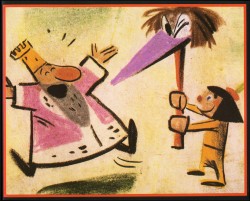
He left it dead, and with its head
He went galumphing back.
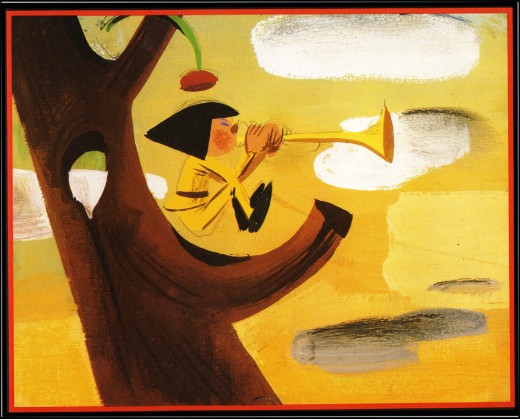
“And hast thou slain the Jabberwock?
Come to my arms, my beamish boy!
O frabjous day! Callooh! Callay!”
He chortled in his joy.
Jim Hill talks a bit about this book on his site in a letter response. here.
For amusement, you might check out this site for translations of this poem into 58 other languages, 23 parodies of the poem, and 10 explanations trying to define what Carroll meant by it.
Tomorrow, I’ll post images from a version I did.
Animation Artifacts &walk cycle 21 Feb 2007 07:54 am
He’s Got Strings
- Hans Perk, on his site A Film LA, has been posting the complete set of Drafts for Pinocchio, and after my post of the Jiminy Cricket run last week, I feel compelled to give more from this great Disney film.
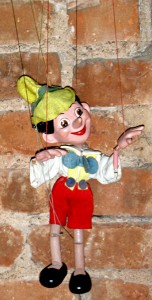 I have this walk – Pinocchio with strings, as operated by Gepetto from above. It’s one of the most complex problems I can imagine, and I think you have to be something of a genius animator to pull it off. Needless to say, Frank Thomas did. He mastered all the challenges of the weight of the object to allow you to completely disbelieve you were watching drawings move, yet you were able to get into the mind of the puppeteer.
I have this walk – Pinocchio with strings, as operated by Gepetto from above. It’s one of the most complex problems I can imagine, and I think you have to be something of a genius animator to pull it off. Needless to say, Frank Thomas did. He mastered all the challenges of the weight of the object to allow you to completely disbelieve you were watching drawings move, yet you were able to get into the mind of the puppeteer.
It’s a brilliant piece of acting. A lifeless creature given life through Gepetto’s manipulation. The scene, of course, contrasts with the “Got No Strings” number where Pinocchio dances among puppets that are manipulated by the professional puppeteer, Stromboli, as opposed to the non-professional, Gepetto. It’s so complex yet done so well that it looks simple.
The drafts list this film as Prod. F3, but the drawings are labelled as F5. I’m not sure what else F5 could stand for since it’s certainly not the seq or sc number. Confusion on my part.
Here they are. Enlarge all images by clicking them.
![]() Note that the drawings read from Right to Left:
Note that the drawings read from Right to Left:
.
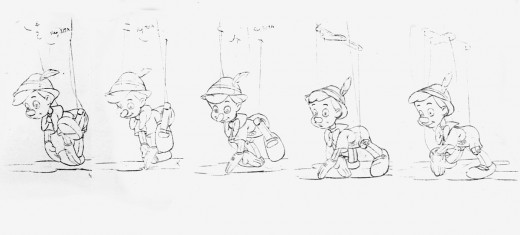
I love Pinocchio’s hand grazing the ground as he’s moved forward. The thrust of his body is all in the head, butt and upper back, as are most marionettes. The strings are an extension of the puppeteer’s hands.
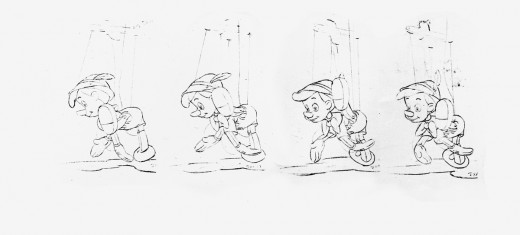
As the foot moves around the rest of the puppet is spun around, too. It’s a beautiful and graceful turn.
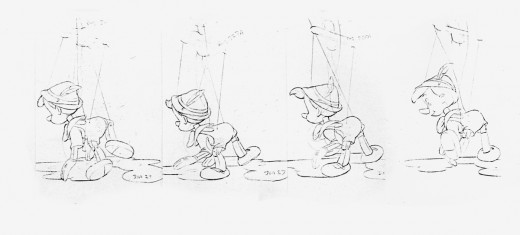
His foot slaps down, and again the hand touches the ground as the puppet prepares to be lifted forward by the offscreen control demands in the play against gravity.
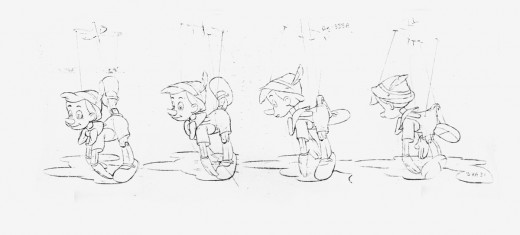
As the back leg goes up and around, the smiling face comes back around to us. Pinocchio’s butt is up there with that foot. A great puppeteer wouldn’t have Pinocchio bent over in this walk, as we see later in Stromboli’s characters.
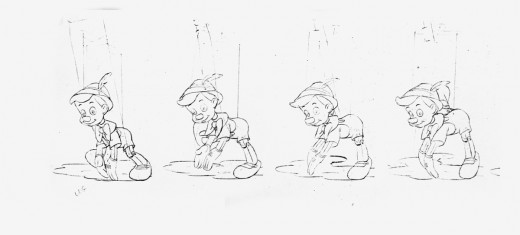
Finally, Pinocchio comes back to the starting point as if this were a normal walk cycle. What a gem of a piece. There were brilliant animators going at it at that studio. Technically, this can be done by some of today’s 2D animators, but I wonder if the meat of the scene would be as good.
Animation Artifacts &Models &UPA 20 Feb 2007 08:04 am
Random Models
- Did I ever mention that I was a model-sheet Junky? I love them, no matter where they come from or how big they are. I enjoy looking at notes on them, how they were constructed, and signatures. The whole package.
They come in so many sizes, forms and designs.
This is why I get off on a couple of sites that post some beauties. The ASIFA Hollywood Animation Archive has done this frequently, e.g here, here and here.
The Disney Informer also offers quite a few models.
Here are a few from from my collection representing different studios. Of course, I’ll start with Disney, the classics:
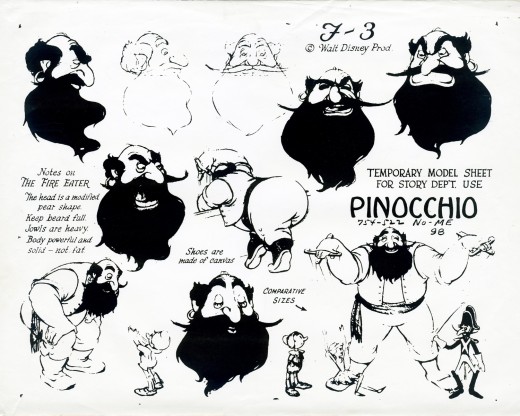
The three models I have are matte photostats, though I believe the handouts were copied onto Disney’s large 5-hole animation paper. On one of these you can see traces of the pegholes.
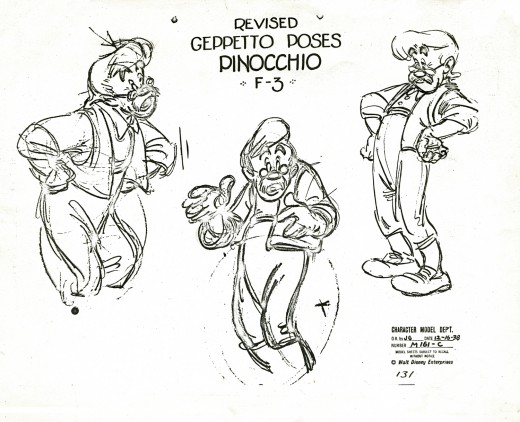
I have a large cel of Gepetto from the pose on the left, hands akimbo. I’m not sure it was ever in the film.
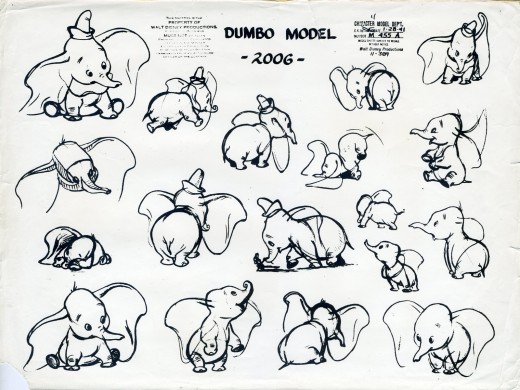
What a beautiful Dumbo. I think I could look at these drawings all day. It’s one of my favorite films. No tricks, no pretensions. Just a great cartoon to make you cry. This is the top of their game.
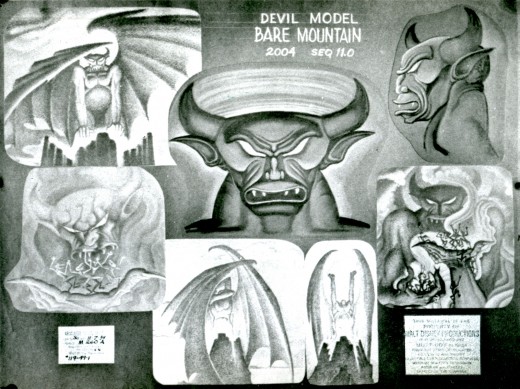
Unfortunately, this one is a photograph I have of the model on a bulletin board. It’s not the best focus.
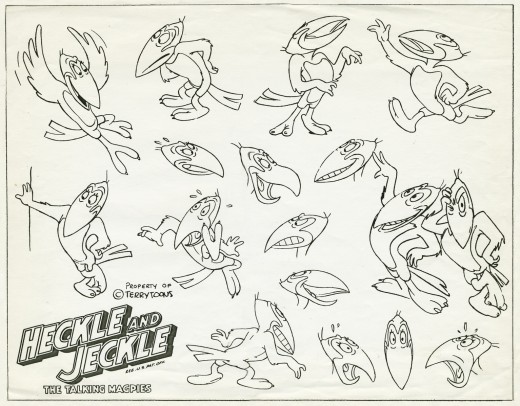
Terrytoons had a beautifully composed model sheet with some fine poses. I wonder how much this helped Jim Tyer. Another Terry model sheet, one of Mighty Mouse, follows. I suspect that Connie Rasinski drew both of them.
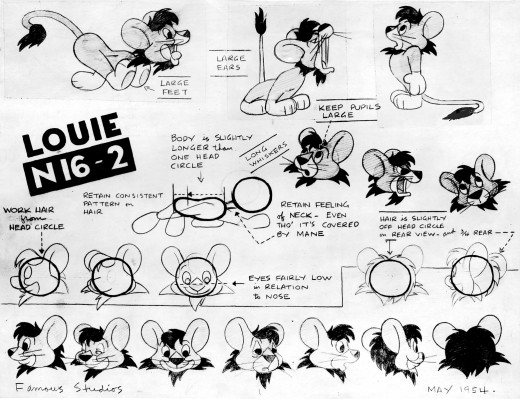
At Paramount, they were a little different. The stats they made, at least those I have, were high gloss. This one has some damage to it where it must’ve gotten wet.
This is the info for this short I found on Dave Mackey‘s invaluable site: Lion In The Roar Rel 12/21/56 – Noveltoon Featuring Louis The Lion, Directed by Seymour Kneitel. Larry Riley drew this model.
I have a couple of the original models which were compiled on animation paper from cut-out drawings. The glue has had a hard time holding up. I gave examples of this last year with an Indian film. See here and here.
The animators received these glossy stats.
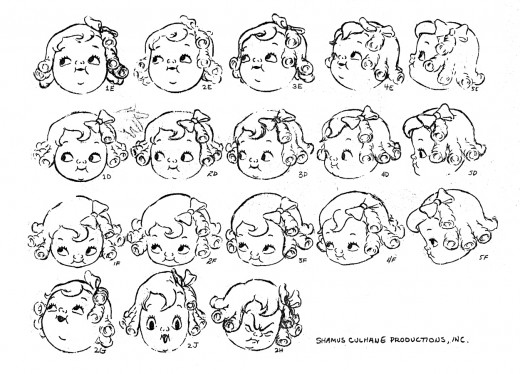
For this Campbell Soup commercial a lot of effort went into drawing the girl. No doubt they were out to please a client. This is the best this character has ever looked.
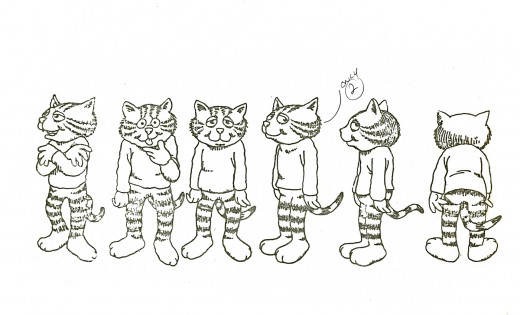
By the time we get to Fritz the Cat, the Xerox machine was in use to make hand-outs for the staff. They didn’t bother with photostats.
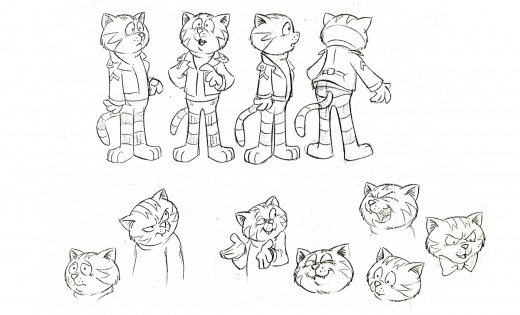
The drawings look like different artists were at work. No wonder the character shifts about on screen. I actually enjoy watching that shift. There’s something alive about it.
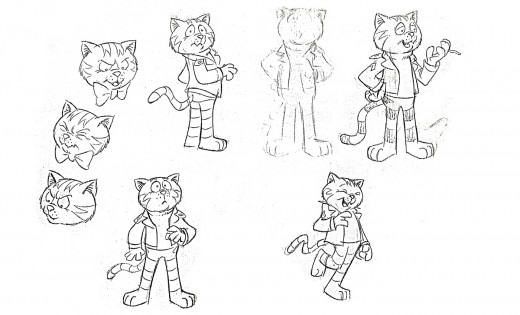
I keep thinking these last two are from The Nine Lives of Fritz the Cat, but I’m sure they came from the original film.
- May I suggest you go to a couple of other sites today, while they’re still fresh. Good work from both of these regular must-read writers.
- Floyd Norman‘s essay over at Jim Hill Media is as great a read to me as anything else he’s written, and I love reading all of his pieces.
- Mark Mayerson has a great piece on his site today whcih certainly got me weathered up. He definitely has some of the most thoughtful, provocative and interesting material on the web.
